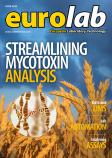A novel, user-friendly platform for looking inside cells in three-dimensions has been developed at B24 at Diamond Light Source. The combination of super-resolution structured illumination microscopy and soft X-ray tomography was put to the test by tracking the early stages of reovirus infection.
The Biological Cryo-Imaging beamline, B24 at Diamond, comprises the transmission cryo-soft X-ray tomography (cryo-SXT) microscope, which allows users to visualise biological samples under near-physiological conditions. Recently, the beamline has been enhanced with the addition of a cryo-structured illumination microscope (cryo-SIM).
A collaborative effort of European scientists saw these two techniques merged to allow users to combine the ultrastructural data from SXT with the fluorescence data from SIM. The power of this novel imaging platform was demonstrated by studying reovirus. The two high-resolution imaging techniques allowed data to be superimposed on the same cell samples in 3D to track events during the early stages of infection.
Combining two powerful techniques
Gaining high-quality imaging data from cells is a challenge; not only immobilising the cells in a way that does not introduce artefacts, but also ensuring the imaging techniques yield information that can cross-correlate.
At B24, the development of a new imaging platform has filled this unmet need. The power of the cryo-SIM and cryo-SXT microscopes have been combined to give valuable insights into the inner workings of biological material. This work was the result of a fruitful collaboration between Diamond and research groups and facilities across Europe (University of Oxford, UK, Heidelberg University Hospital, Germany, Université de Nantes, France, CryoCapCell, Paris, France and Micron, which is based at the Department of Biochemistry at the University of Oxford).
Dr Maria Harkiolaki, Principal Beamline Scientist at B24 and lead author of the study, explained the motivation behind combining the techniques, “One method gives you a chemical signature and the other method gives you ultrastructure and content, literally a CT scan of a cell with highlighted areas of interest. Put them together and you not only have a 3D map of a cell, but also the location within that map of any chemical entity you are interested in.”
The new imaging platform was put through its paces by tracking the way in which reoviruses infect a cell. Reoviruses are well-studied benign viruses and promising candidates for gene therapy vectors. Although they been researched extensively, the way in which the viruses enter cells and release their contents is debated. The virus uses endosomal vesicles to enter cells, but it is not fully understood how it escapes this vesicle to produce progeny.
Determining the location of the virus and vesicles
Human cells grown on gold grids were infected with reovirus and samples were plunge-frozen after 1, 2 and 4 hours. At each of these time points the cells were imaged using SIM-SXT to determine the location of the virus and its carrier vesicles. “When you look at cells in a normal microscope, they aren’t very photogenic – you don’t see many things as they are usually transparent. But when we use these lasers, we can highlight and track the virus and we had a reporter chemical that told us when the carriers’ membranes had been compromised,” explained Dr Harkiolaki.
After 2 hours, the fluorescence data showed that the virus had already escaped from the vesicles that contained it. The data was enhanced by merging this information with the X-ray microscopy, which allowed the team to see both carriers and virus alongside other cellular structures. The vesicles still appeared round in the images despite the virus already escaping, which hinted towards a gentle exit via pores within the vesicle because preservation of the round shape would not have been possible if the virus had ruptured the vesicle to escape.
User-friendly and accessible
The elucidation of the infection mechanism of the reovirus was made possible with the new platform, and its applications extend far beyond this proof-of-concept experiment. It has already been used for to track cell morphology changes during development, delivery of anti-cancer compounds, pathogen clearance by immune cells and seeing into yeast, algae, bacteria and archaea.
Importantly, this work perfectly demonstrates what can be achieved by multidisciplinary collaboration. “We have virologists from German and UK institutes with the real-life need for multidimensional imaging of cell populations at near physiological states, imaging development experts from Diamond and the University of Oxford and finally software developers from Diamond and France coming together to produce a really integrated imaging platform that is accessible and user-friendly,” said Dr Harkiolaki.
The platform will continue to be improved and will also be fully automated in the future. In the meantime, despite the COVID-19 pandemic, experiments can be conducted remotely and the methodology is accessible online to help the scientific community take advantage of developments at B24.
3D rendering of the cryoSIM recorded structures displaying viral green fluorescence within the cytoplasm and 3D semi-transparent rendering of all cytoplasmic vesicles that contain viruses.
The X-ray tomogram of the cell that contains these structures is represented by the grayscale slices of its planes with the associated cellular structures clearly delineated.







